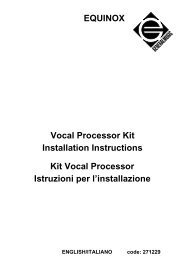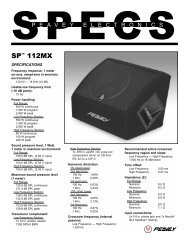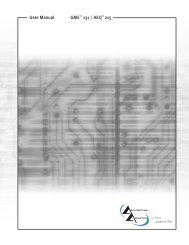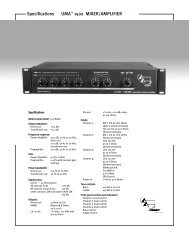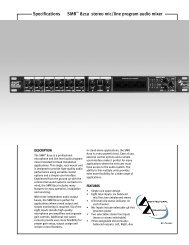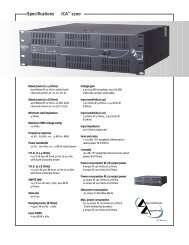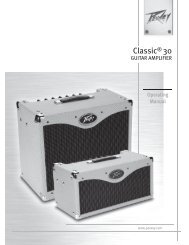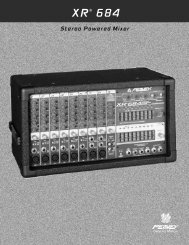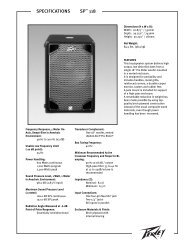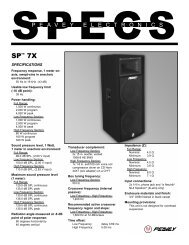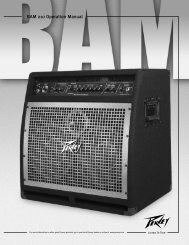GPS Series Amplifiers GPS Series Amplifiers - Peavey
GPS Series Amplifiers GPS Series Amplifiers - Peavey
GPS Series Amplifiers GPS Series Amplifiers - Peavey
Create successful ePaper yourself
Turn your PDF publications into a flip-book with our unique Google optimized e-Paper software.
All other <strong>GPS</strong> models:<br />
These models offer dual Speakon ® Quick Connectors. The Speakon ® is a four-wire connector with the<br />
connections labeled as 1+, 1-, 2+ and 2-. The Speakon connectors found on your <strong>GPS</strong> <strong>Series</strong> amplifier<br />
are connected with pins 1+ and 2+ wired in parallel to the positive output. Pins 1- and 2- are wired in<br />
parallel to the negative output. This is typical for each channel.<br />
NOTE: Consult your loud speaker specifications to determine the wiring configuration that will best<br />
suit your system. The diagrams on pages 13 and 14 display the recommended hookup for your <strong>GPS</strong><br />
<strong>Series</strong> amplifier. In addition to the Speakon ® Quick Connectors, Binding Posts (10) are also provided<br />
for each channel.<br />
10. BINDING POST OUTPUT CONNECTORS<br />
Five-way binding post speaker outputs can be found on each channel regardless of model. For each<br />
channel, the outputs are in parallel, hence the speaker connection cables can be terminated with banana<br />
plugs or stripped wires for use in the binding post terminals as well as the output connectors (9). For<br />
sustained high power applications, the use of the binding post terminals is recommended; however,<br />
care must be exercised to assure the correct speaker polarity. The red binding posts are the signal<br />
outputs from each channel, and the black binding posts are chassis ground. The red binding post should<br />
be connected to the positive inputs of the associated loudspeakers. For “bridge” mode operation, only<br />
the red binding posts are used, and the associated loudspeaker load is connected between the two red<br />
binding posts. The red binding post associated with Channel A should be considered the positive output<br />
for the system and thus should be connected to the positive input of the associated loudspeaker system.<br />
WARNING: Regardless of what connections are used, the minimum parallel speaker load should<br />
always be limited to 2 ohms per channel or 4 ohms “bridge” mode for any application. Operation at<br />
loads of 4 ohms per channel or 8 ohms “bridge” mode is more desirable for sustained operation<br />
applications due to the fact that the amplifier will run much cooler at this loading. Operation above 4<br />
ohms per channel and even open circuit conditions can always be considered safe; however, sustained<br />
operation at loads below 2 ohms could result in temporary amplifier shut down due to the thermal<br />
limits fault circuitry.<br />
DDT COMPRESSION<br />
11. DDT DEFEAT<br />
This switch is used to defeat the DDT compression used to protect against signal clipping. Only the<br />
<strong>GPS</strong> 900 and 1500 models offer this feature. It is recommended to leave the DDT compression<br />
enabled at all times to protect your speakers from damaging square waves. The DDT function is<br />
disabled when the switch is pressed to the “in” position. The DDT LEDs (12) will illuminate when<br />
DDT compression is occurring in that particular channel.<br />
FRONT PANEL CONTROLS/INDICATORS<br />
The following section describes the controls and indicators found on the front panel of your <strong>GPS</strong> <strong>Series</strong><br />
amplifier. The Power Switch and LED are explained in a previous section, AC Power.<br />
8



